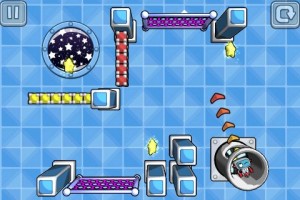 When the Doctor is Away, the Robots Will Play
When the Doctor is Away, the Robots Will Play
It’s eleven o’clock; do you know where your robot assistant is? That’s what the Dr. Wily-esque scientist who created the stage for Mobile Snap’s iOS debut should have asked himself after turning in for the evening. His cute little robot helper has snuck right back into the Gravity Lab! (Out Now, $0.99), and for some unknown reason it’s got its eyes on all the cool yellow stars suspended within — not to collect them, but rather to smash them with gravity cubes stacked all over the place. The poor scientist whose anti-gravity research made all this possible is going to be ticked when he checks in to find his lab in shambles the next morning!
Let’s get the bad news out of the way first: yes, Gravity Lab! is yet another physics puzzler in the Angry Birds vein. Now for the good news: it’s totally awesome, and stands out from the crowd thanks to its gravity-switching mechanics. As expected in this genre, the player’s job is to fling the protagonist into blocks, this time by revving up a giant turbine with a pull-forward motion. The objective is to crash the robot into stacks of cubes so that they collide with stars on their way down. Or on their way up, or to the left, or to the right, as cubes are color-coded according to the direction they “fall” in once displaced.
 The robot ricochets right offscreen as soon as it crashes into something. Therefore, Gravity Lab!‘s challenge lies in figuring out a release path that will translate the robot’s initial momentum into the multiple impacts needed to obliterate all three stars in each level. Think of it as a game of dominoes where some blocks fall up, others down, and you’ll have a good grasp on where this is going. While genre staples like reflective springboards and bombs get their fair share of the spotlight, the real stars are gravity fields that alter the direction of anything falling through them, whether it be the robot or displaced cubes. Barring leaps of insight, each level’s solution is figured out through gradual experimentation once the player’s been eased in by a couple introductory levels.
The robot ricochets right offscreen as soon as it crashes into something. Therefore, Gravity Lab!‘s challenge lies in figuring out a release path that will translate the robot’s initial momentum into the multiple impacts needed to obliterate all three stars in each level. Think of it as a game of dominoes where some blocks fall up, others down, and you’ll have a good grasp on where this is going. While genre staples like reflective springboards and bombs get their fair share of the spotlight, the real stars are gravity fields that alter the direction of anything falling through them, whether it be the robot or displaced cubes. Barring leaps of insight, each level’s solution is figured out through gradual experimentation once the player’s been eased in by a couple introductory levels.
While Gravity Lab!‘s mechanics are easily picked up, it could definitely use a quickly accessible cheat sheet to remind the player which color corresponds to each gravitational direction; this information is tucked into a static tutorial that’s a couple taps away, and the player has to flip through it before reaching the helpful color primer. Despite my preference for pull-back over pull-forward when it comes to fling interfaces, I must admit that Mobile Snap did a great job coupling direction and magnitude into an intuitive arrow system. Players will also appreciate that the previous release path remains traced onscreen when it’s time for a re-try, as this helps the player efficiently fine-tune the robot’s trajectory.
 Gravity Lab!’s soft music and pastel cel shading go extremely easy on the senses. While presented mostly in 2D, Gravity Lab! rewards the player with really cool Matrix-style camera pans and zooms as cubes close in on the final star of a perfectly completed level. On the downside, this cool visual effect becomes a needlessly drawn-out affair if the player barely misses; the action resumes normal speed only if the final star is actually struck, leaving a laborious countdown if the player wants to proceed after a non-perfect level instead of hitting the re-start virtual button.
Gravity Lab!’s soft music and pastel cel shading go extremely easy on the senses. While presented mostly in 2D, Gravity Lab! rewards the player with really cool Matrix-style camera pans and zooms as cubes close in on the final star of a perfectly completed level. On the downside, this cool visual effect becomes a needlessly drawn-out affair if the player barely misses; the action resumes normal speed only if the final star is actually struck, leaving a laborious countdown if the player wants to proceed after a non-perfect level instead of hitting the re-start virtual button.
Weighing in at three laboratories filled with a total of 75 levels upon release, Gravity Lab! can be counted on for at least four hours of play.
iFanzine Verdict: Just about the only thing you can hold against Gravity Lab! is that it vies for attention in a packed genre, and begs for more readily accessible hints as the player wades through its considerable depth. Otherwise it stands out for its unique gravity-switch formula and superior design polish.
[xrr rating=4.5/5]


